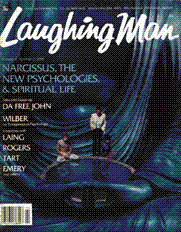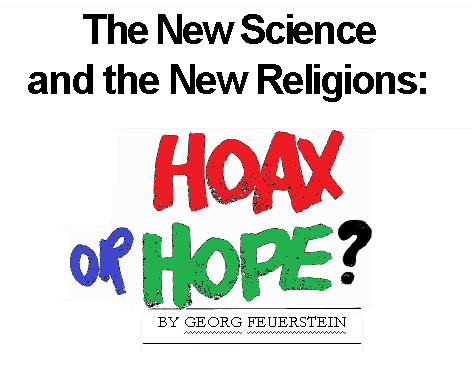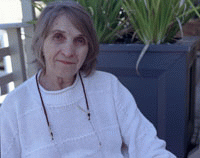

The New Science and the New Religions:
Excerpted from The Transmission of Doubt (The Dawn Horse
Press, 1984), pp. 39-47
There is extensive agreement that Man stands today at
the crossroads – a historical moment that is possibly more
decisive than any other. The potential for unprecedented
destruction and the genocide of our race is delicately
balanced against the possibility of global cooperation and a
great cultural renaissance. Many people look to science to
provide a benign resolution to the present crisis, while
others see the mushrooming new therapies as signs of the
dawning of a New Age. Yet clearly, both science and the new
therapies are egoic endeavors, and as such they are liable
to reinforce our personal and culture wide dissociative
tendencies.
In the following piece Georg Feuerstein takes a
careful look at the possible pitfalls that lie on the paths
of scientific or therapeutic salvation.
The problems that mankind
faces are very real and serious. However, contrary to Oswald
Spengler, who boldly prophesied the decline of our
Occidental civilization, the outcome of the present global
crisis is not predictable. The button that would release a
thick swarm of lethal missiles to crisscross the continents
could well be pushed accidentally or by an undiagnosed
military psychopath. But it need not. Good sense and
vigilance might prevail. The nations of the world may even
learn to cooperate in time to avoid the specter of economic
disaster.
Not all who speak up about the world crisis are prophets
of doom. There are many, such as Jean Gebser, Aurobindo
Ghose, and Pierre Teilhard de Chardin, who see new wine
manifesting in old bottles. A long list of scholars and
writers in the field of the humanities could be added. Among
the better-known personalities that would have to be
mentioned are Marshall McLuhan, Lewis Mumford, Pitirim A.
Sorokin, Buckminster Fuller, Harold Schilling, Charles A.
Reich, Abraham Maslow, Carl Rogers, Barbara Marx Hubbard,
Theodore Roszak, and Marilyn Ferguson each approaching this
issue from his or her own unique perspective.

Marilyn Ferguson has made the latest attempt not so much
to create a new overarching model for the emergent
conditions as to describe what she once called “The Movement
That Has No Name.” Although in her widely acclaimed book The
Aquarian Conspiracy she confines herself to charting the
“leaderless but powerful network” of reform-minded
professionals in different disciplines in the United States,
the implications of her findings go clearly beyond the
national boundaries of North America. The “Aquarian
conspirators” are located in many other countries as well,
including some that lie behind the invisible Iron
Curtain.
Whereas the new therapies with
their pseudo-religious pretensions are pointedly
person-centered, the New Science continues the
centuries-long fascination with the universe at
large.
The demolition of the medieval, Christian world-view by
the Renaissance sciences left generations of people
benumbed, in doubt, or anxiously clinging to demonstrably
irrational beliefs. In the eighteenth and nineteenth
centuries the intelligentsia-no longer at ease with
Christian dogmatism found its haven in science, which was
promptly converted into the pseudo-religion of scientism to
meet the meager emotional expectations of the left-brained
individual. The population at large, however, continued to
profess the Christian faith while at the same time,
particularly in the illiterate strata of society, deriving a
great deal of practical meaning from astrology, magical
healing, divination, and witchcraft – an almost schizoid
split that is characteristic even of a large section of our
contemporary society. (Significantly, there are about ten
thousand “professional” astrologers in the U.S.A. as against
some two thousand astronomers!)
The extreme rationalism of scientism, not surprisingly,
is an unattractive diet to those who look for deeper
meanings but for whom the religious establishment is remiss
in supplying a wholly convincing way of life. Many do not
have the independence of mind to openly confess their
apostasy and so continue to pay lip service to their
inherited religion. Still, over the last couple of decades
church membership, never mind active participation, has
dwindled significantly in nearly all industrialized
countries of the Western hemisphere. The ecumenical spirit,
which the anxious clergy hoped would be a timely panacea for
their institutional problems, proved rather ineffective.
While the great denominations are facing the increasing
exodus of their flock, sectarian groups, like the Jehovah’s
Witnesses and the Pentecostal churches, are steadily
recruiting members from among those who dread a fluid, open
world and who need the apparent security of the tight,
provincial framework of fundamentalist religion: Here
seeking is ended before it has begun. Hence, transcendence
becomes an impossibility.
If Christianity offered no solace, if the “revivalist”
sects of Christianity and the “neo-orthodoxy” of Judaism
proved too claustrophobic, if scientism did not satisfy the
craving for existential meaning, and if the age-old
superstitions and folk mythology were no more than poor
substitutes taken with a pinch of salt or in desperation and
anguish, then obviously a new answer had to be found.
“Nature abhors a vacuum” – at least human nature. At first
it was hoped that the new discipline of psychology, chiefly
in the form of psychoanalysis, could fill the gap left by
the rapid decline of civic religion. That decline had of
course been precipitated by psychology itself, which in a
way led the criticism of religion by the natural sciences to
its (bitter) end. However, psychoanalysis was not
constituted of the same stuff that religions are made of and
was even less equipped to counter existential anxiety and
spiritual alienation. The principal reason for this failure
was presumably the scientistic slant of psychoanalysis, with
its positivistic model and behavioristic program for
individual readjustment. Another important reason is, I
think, the fact that despite its scientific pretensions,
psychoanalysis has not freed itself from the weight of the
peculiarly Hebrew and Christian preoccupation with the
morbid side of our psychic life and the seemingly all
pervasive sense of guilt. Is it: not the psychoanalyst’s
sacred obligation to exorcise the demons of warped guilt,
twisted Oedipal desires, other oppressive secrets, and a
felt sense of unworthiness from the dark niches of the
neurotic’s unconscious?
Nevertheless, psychoanalysis gave birth to a whole range
of new therapies that, today, compete with each other to
remedy the psychopathology of our ailing civilization. They
are, or propose to be, the secular man’s answer to his
spiritual emptiness. Their emphasis is on “personal growth,”
“self-actualization,” “consciousness expansion,”
“aliveness,” and “psychic health.” Dwelling as they do on
the positive (if not hedonistic) side of human nature-on
Man’s “potential,” his creative capacity, and his ability to
live a “happy” life-these therapies understandably enjoy
considerable popularity, augmented by the fact that many
also surround themselves with a messianic aura. They tend to
congeal into quasi cults, with a charismatic, authoritarian
leader in the center, whose patients actively live out the
neurotic fantasy of “being as little children.” Even where
such overt cultism does not occur, these therapies often
indirectly encourage faddism and a mentality of dependence,
which defeat their very raison d’etre.2
Their attraction lies to a large extent in the fact that
they take the individual and his problems seriously, giving
him an opportunity to tackle his difficulties and to explore
himself on his own terms, without having to submit-so the
ideology goes-to any external authority. In other words, the
narcissistic person is met on his own ground as a consumer
of therapeutic experiences. What could be a potentially
rewarding approach to self transcendence generally winds up
being a kind of experiential merry-go-round that consoles
and gratifies rather than helps to transcend the ego. Where
these popular therapies break out of this fun-and-games
milieu, they assume a distinctly religious complexion, the
inspiration for which comes, as a rule, from one or the
other authentic religious tradition of the East Buddhism,
Zen, Taoism, Hinduism, Tantrism, Yoga, Sufism.
.. the avant-garde researchers of
the New Physics are eagerly turning to Eastern mysticism,
delighting in the esoteric confirmations for the paradoxes
of quantum phenomena.
In fact, one of the most significant metamorphoses today
is the Orientalization of the West. This is an immediate
consequence of the expansion of Western economic and
political interest into the East. Widespread disenchantment
with Christianity, the first Eastern cult to take root in
the Occident, and the growing unease about scientific
materialism has once again opened up the gates to the wisdom
of the East. The ground for this cultural osmosis was
prepared by the German romantic philosophers (Fichte,
Schelling, etc.) and the American transcendentalists
(Emerson, Thoreau, etc.) who influenced the English
“metaphysical poets” (foremost Blake, Carlyle, and
Coleridge). The activities of the Theosophical Society
(founded in 1875), the dawn of Buddhist studies in Europe,
and somewhat later the encyclopedic work of C. G. Jung
proved singularly potent catalysts in this great
process.
However, the influx of Oriental ideas and values gathered
critical momentum with the blossoming of the so-called
“youth counter-culture” of the late sixties and early
seventies, which superseded the rootless beatnik generation.
Psychedelic experimentation, first vociferously advocated by
Aldous Huxley, dealt the death blow to the conventional, if
reactionary, attitudes of the youth culture of the fifties.
And it called into question the materialistic establishment
itself. Yet, the hippies and “flower children” grew into
adults, many of whom became solid, law abiding citizens
after all. Still, the drug culture of that period, fired by
the rebellious minds of Timothy Leary, Alan Watts, and Allen
Ginsberg, has left indelible marks on American and European
society and culture. These marks are partly wounds, partly
auspicious signs.
In his book The Awareness Trap, Edwin Schur has drawn our
attention to the dangers inherent in the contemporary
movement toward what he calls “selfabsorption “- the
erroneous ideology of awareness as a panacea for all
personal and social ills.3 While Schur’s
appraisal of the social value of individual growth is
exaggeratedly pessimistic, he rightly pointed out that most
of these much propagandized awareness techniques and
programs are a mere travesty, and they all lack the
spiritual soundness of the great religious and mystical
traditions. Thus, they cannot be expected to heal the
Western psyche from its civilizational malaise of “boredom,
doubt, and discomfort” (Da Free John).
However, all this seeking over the past two decades has
been positive inasmuch as it has greatly promoted the cause
of the Eastern liberation teachings within our Western
culture, thereby sensitizing us to a hitherto neglected
dimension of human capability. Most significantly, typically
Oriental ideas have even penetrated the stronghold of our
materialistic civilization-the scientific establishment. The
“New Science,” like the new religions and quasi-religions,
is remarkably Orientalized. What is more, both the New
Science and the new religions share another feature: they
have strong liabilities.
Whereas the new therapies with their pseudo-religious
pretensions are pointedly person-centered, the New Science
continues the centuries-long fascination with the universe
at large. Thus, they perpetuate, each in its own fashion,
the artificial value-laden disjunction between individual
and world, inner and outer universe. If the new therapies
glorify experience and therefore irrationalism, the New
Science, although it debunks the simplistic rationalism of
the Newtonian paradigm that it endeavors to replace, still
holds up the left-brained approach to reality. As always,
therefore, scientists are exposing themselves to the
anachronistic fallacy of mistaking the facsimile reality
conjured up by thought for the Real Thing. Even though
quantum physics is mirroring to them an inexhaustibly
complex and ultimately inconceivable universe, they are
quite undaunted by this. Indeed, their intellects are
excited by the prospect of a never-ending voyage of enquiry,
just as the experience-hungry therapists and their clientele
are encouraged in their inward odyssey by the fact that the
human personality is a vastly intricate, multidimensional
system. The joy is in traveling not in arriving, they say.
But is it?
Self-exploration and the investigation of the world are
basic forms of seeking. And seeking is, as Gautama the
Buddha preached and as the modern Adept Da Free John
reaffirms, a disease of the ego by which it struggles to
block out the knowledge of its own mortality and suffering.
But seeking itself is suffering, because it is an indirect
affirmation of the fallacious sense of egoic separateness.
This becomes clear when the search at last winds down.
Before this is possible, however, Man must have come to at
least a minimal understanding of the mechanism of
individuation through which he singles himself out from the
total ecology of existence.
Yet, the new therapies are unlikely to arrive at this
point of recognition unless they desist from equating
experienced reality with Reality. Likewise, the New Science
must come to the understanding that a conceived or thought
reality is not identical with Reality. This is an obvious
point but one that does not appear to be heeded much.
Consequently, there is the very real danger that, in their
exuberance over knowledge and experience, the new therapies
and the New Science might blindly fall in love with each
other and authenticate each other’s aspirations as
alternative religions for the modern age. The guruism of the
new therapies is all too apparent, and who would wager that
the New Science does not carry the virus of pseudo-religious
hubris from which scientism is suffering so mightily?
To be sure, the avant-garde researchers of the New
Physics are eagerly turning to Eastern mysticism, delighting
in the esoteric confirmations for the paradoxes of quantum
phenomena. Gary Zukav writes:
“The development of physics in the twentieth century
already has transformed the consciousness of those involved
with it. The study of complementarily, the uncertainty
principle, quantum field theory, and the Copenhagen
Interpretation of Quantum Mechanics produces insights into
the nature of reality very similar to those produced by the
study of eastern philosophy. The profound physicists of this
century increasingly have become aware that they are
confronting the ineffable. “4
But, as befits scientists of good standing, these
physicists are confronting the Ineffable with the intellect,
and therefore the changes in consciousness mentioned by
Zukav are only skin-deep. They do not signal the kind of
fundamental transformation of the whole being that results
from a direct confrontation with the great Mystery, not
merely by the mind and its homely icons, but by everything
that Man represents, through immediate Realization of the
Real. Master Da Free John offers this penetrating analysis
of the cerebral approach:
“Thinking about Reality is not the way to be in touch
with It. Thinking is something you do by standing back: You
contract, you turn away, you turn inside or become involved
in the programmed mechanisms of the verbal mind, hoping to
discover something that will give you some excuse, some
reason for returning to Reality openly, for feeling good
about it. You are trying to find some reason why you should
surrender, why you should let go, why you should let
yourself be vulnerable in the midst of this mortal
circumstance. “5
The Eastern mystics to whom modern physicists turn did
not arrive at their ontologies by mere abstraction. Their
philosophical ideas grew on the soil of mystical experience
and were nourished, in at least some instances, by the
ambrosia of ultimate Realization or perfect Enlightenment,
which transcends all experiencing. Hence also their
metaphysical structures, though apparently paralleling those
of contemporary quantum physics, are firmly tied into Man’s
moral life: They serve as maps of spiritual growth, if
predominantly through mystical introversion.
While the interpretation of reality proposed by the New
Science is to be welcomed, it is still limited and certainly
provisional. Therefore, it would be premature to draw
far-reaching conclusions purely on the basis of the current
research and speculations. And yet, the knowledge of the New
Science contains important cues for a healthy departure from
the rationalist-mechanistic interpretation of Nature that
continues to dominate much of contemporary thought and life.
Nevertheless, the lack of a truly comprehensive
understanding-informed not by opinion, belief, or wishful
thinking but by Transcendental Realization-in the new
therapies or religions and in the New Science greatly
hampers their free development and ultimate usefulness for
Man. Without the kind of radical orientation found in the
Teaching of the Adept Da Free John, the new therapies are
likely to fall victim to the “heresy” of religious
provincialism, whereas the New Science is prone to succumb
to the equally obnoxious error of scientism (perhaps not of
the materialist brand, but with the same totalitarian
pretensions).
1. Marilyn Ferguson, The Aquarian Conspiracy (Los
Angeles: J. P. Tarcher, 1980).

2. See M. K. Temerlin and J. W. Temerlin, “Psychotherapy
Cults: An latrogenic Perversion,” Psychotherapy: Theory,
Research, and Practice, vol. 19, no. 2 (Summer 1982),
pp.131-41. Remarkably, these quasi-religious therapies
attract even the cleric. Ralph Wendell Burhoe observes:
“Traditional religious and theological doctrines of the soul
and its salvation are seldom heard, unless outspoken
fundamentalists happen to be around. The older religiously
related tradition is increasingly forgotten, and the new
secular psychotherapies are openly advocated by churchmen.”
R. W. Burhoe, “Some Prophecies of Twenty-first-Century
Technology and Religion,” in Science and Human Values in the
21st Century, ed. R. W. Burhoe (Philadelphia: Westminster
Press, 1971), p. 41. See also R. W. Burhoe, “Bridging the
Gap between Psychology and Theology,” Journal of Religion
and Health, vol. 7, no. 3 (July 1968), pp. 215-26.
3. See E. Schur, The Awareness Trap: Self-Absorption
instead of Social Change (New York: McGraw-Hill, 1977).
4. G. Zukav, The Dancing Wu Li Masters: An Overview of
the New Physics (New York: William Morrow, 1979), p.
330.
5. From an unpublished talk given by Da Free John on
August 13, 1983
|



